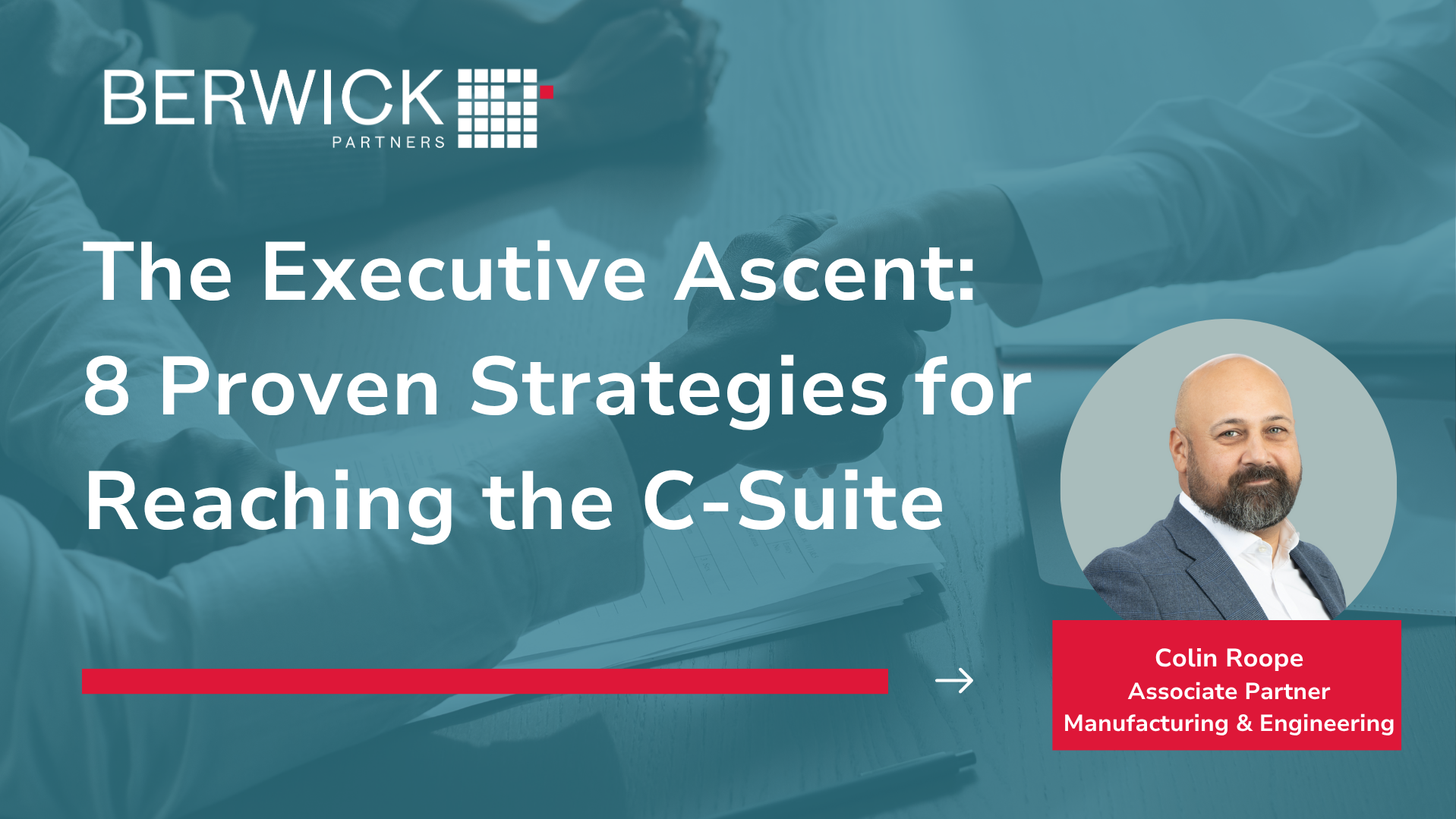The Executive Ascent: 8 Proven Strategies for Reaching the C-Suite
Throughout my career, I have had the privilege of working closely with a wide range of senior leaders. Some are already occupying top-tier roles, while others are steadily progressing through the ranks. Over time, clear patterns have emerged in the behaviours, mindsets, and decisions that distinguish those who successfully transition into executive leadership from those who remain at the senior management level.
The journey to the executive suite is not simply a matter of tenure or technical expertise. It is a deliberate evolution that requires a shift in perspective, a commitment to personal growth, and the ability to lead with both vision and authenticity.
The eight following strategies encapsulate the core attributes and actions that define successful executive leaders.
-
Cultivate Executive Presence and Gravitas
One of the most immediate and impactful differentiators of executive-calibre leaders is their executive presence. This is not about physical stature or charisma, but rather the ability to project confidence, authority, and composure in any setting.
Executive presence is often described as the ability to command a room without uttering a word. It is the calm assurance that inspires trust and signals capability. Fortunately, this quality is not innate. It can be developed through self-awareness, emotional regulation and consistent demonstration of competence under pressure.
-
Transition from Tactical Execution to Strategic Leadership
Many high-performing managers excel in operational execution. They are problem-solvers, detail-oriented, and results-driven. However, these traits alone do not qualify one for executive leadership.
The most successful leaders make a conscious shift from being highly effective managers to becoming strategic thinkers. They elevate their focus from day-to-day operations to long-term vision and organisational growth. They empower their teams to operate autonomously, coach others to solve problems, and reserve their own involvement for high-impact decisions. Strategic thinking becomes their default mode, not an occasional exercise.
-
Broaden Functional Experience to Build Organisational Credibility
A common trait among those who ascend to Managing Director or Chief Executive roles is having cross-functional experience. These individuals have intentionally moved beyond their core disciplines, whether in sales, engineering or operations, to gain exposure to other areas of the business.
This breadth of experience enhances their credibility across departments and equips them with a holistic understanding of the organisation. It enables them to identify and activate the right levers for performance improvement. A compelling example is the Managing Director (MD) of an automotive company – someone I’ve known since the start of his career. Beginning his career in quality assurance, he expanded his remit across multiple functions, including international operations, and ultimately positioned himself as a well-rounded and highly effective leader.
-
Deliver Tangible Results and Articulate the Journey
While delivering results is a prerequisite for advancement, the ability to communicate the narrative of one’s impact is equally critical.
Many candidates present their careers in a linear, transactional manner. What distinguishes exceptional leaders is their capacity to articulate transformation. For example, “I joined the organisation at point A, implemented strategic initiatives B and C, and achieved outcomes D and E.” They highlight not only what was accomplished, but how it was achieved, and they acknowledge the contributions of their teams.
This narrative approach demonstrates strategic thinking, leadership maturity and an understanding of organisational dynamics.
-
Build and Empower High-Performing Teams
No leader succeeds in isolation. The most effective executives are those who build exceptional teams, recognise their own limitations, and surround themselves with individuals who complement their skill sets.
The MD I mentioned earlier exemplifies this principle. Throughout his career, he has consistently identified areas where he lacked expertise and recruited top talent to fill those gaps.
This is not a sign of weakness. It is a hallmark of self-awareness and strategic leadership. Moreover, these leaders invest in succession planning, ensuring that their teams are equipped to grow and thrive independently.
-
Embrace Discomfort as a Catalyst for Growth
Leadership is inherently uncomfortable. It demands risk-taking, vulnerability and continuous adaptation. Those who thrive at the executive level are those who embrace discomfort as a necessary condition for growth.
Whether stepping into unfamiliar roles, navigating complex challenges or engaging in public forums, successful leaders lean into the unknown. In interviews, I often ask candidates to describe a time they were out of their depth. Their responses reveal much about their resilience, adaptability and leadership potential.
-
Foster a Culture of Challenge and Diverse Thinking
Executives must be open to constructive challenge and diverse perspectives. This means cultivating leadership teams that do not simply echo their views but instead bring varied experiences and viewpoints to the table.
The most effective leaders create environments where disagreement is welcomed, ideas are rigorously tested, and decisions are made collaboratively. This requires emotional intelligence, humility, and a genuine commitment to inclusive leadership.
-
Lead with Emotional Intelligence and Authenticity
Finally, the most effective leaders are those who lead with emotional intelligence and authenticity. They are self-aware, empathetic and resilient. They do not pretend to have all the answers, nor do they shy away from vulnerability.
A notable example is the MD of a UK manufacturing business, who I’ve had the pleasure of working with over the past few years. She openly discussed her experience with imposter syndrome early in her leadership journey. Her authenticity and willingness to be human resonated deeply with her team.
However, vulnerability must be paired with action. Without it, it can then be seen as a weakness. Authentic leadership is about showing up as your true self, but doing the work to grow.
Leadership: A Deliberate Evolution
The path to executive leadership is not linear, nor is it guaranteed. It requires intentional development, strategic thinking and a deep commitment to empowering others.
Aspiring leaders should reflect on the following:
- Am I cultivating presence and projecting capability?
- Am I thinking strategically and empowering my team?
- Am I broadening my experience and building cross-functional credibility?
- Am I embracing discomfort and seeking diverse perspectives?
Those who reach the top are not merely more experienced. They are more evolved. They have made the conscious decision to lead with purpose, authenticity and vision.
If you would like to have a conversation about your leadership journey or talk about hiring your next leader, please get in touch.






